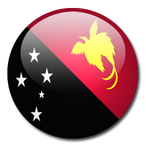International Headteacher
Menu
Full name: The Independent State of Papua New Guinea
Population: 6.9 million (UN, 2010)
Capital: Port Moresby
Area: 462,840 sq km (178,704 sq miles)
Major language: English, Tok Pisin, Hiri Motu
Major religions: Christianity, indigenous beliefs
Life expectancy: 61 years (men), 66 years (women) (UN)
Monetary unit: 1 kina = 100 toea
Main exports: Gold, petroleum, copper, coffee, palm oil, logs
GNI per capita: US $1,300 (World Bank, 2010)
Internet domain: .pg
International dialling code: +675
Population: 6.9 million (UN, 2010)
Capital: Port Moresby
Area: 462,840 sq km (178,704 sq miles)
Major language: English, Tok Pisin, Hiri Motu
Major religions: Christianity, indigenous beliefs
Life expectancy: 61 years (men), 66 years (women) (UN)
Monetary unit: 1 kina = 100 toea
Main exports: Gold, petroleum, copper, coffee, palm oil, logs
GNI per capita: US $1,300 (World Bank, 2010)
Internet domain: .pg
International dialling code: +675
|
Papua New Guinea occupies the eastern part of the world's second largest island and is prey to volcanic activity, earthquakes and tidal waves. Linguistically, it is the world's most diverse country, with more than 700 native tongues.
Some 80% of Papua New Guinea's people live in rural areas with few or no facilities of modern life. Many tribes in the isolated mountainous interior have little contact with one another, let alone with the outside world, and live within a non-monetarised economy dependent on subsistence agriculture. A very small proportion of the land can sustain cash crops, including coffee and cocoa. Abundant rainforests provide the raw material for a logging industry, which is dominated by Malaysian-owned companies. Conservation groups have criticised the social and environmental impact of the activity. Mineral deposits - including gold, copper and nickel - are extensive, but the difficult terrain and poor infrastructure make exploitation slow. There are significant reserves of oil and natural gas and the country has pinned its hopes on becoming a significant energy exporter. The separatist struggle in the neighbouring Indonesian province of Papua, formerly known as Irian Jaya, prompted the flight of thousands of Papuans into Papua New Guinea from the mid-1980s onwards. Many of them remain in border-area jungle camps. The Papua New Guinean government has said it will not tolerate the use of its territory for separatist attacks on the Indonesian army. Papua New Guinea had to deal with separatist forces of its own on the island of Bougainville in the 1990s. Up to 20,000 people were killed in the nine-year conflict which ended in 1997. A peace deal signed in 2001 provided the framework for the election in 2005 of an autonomous government for Bougainville. Papua New Guinea has strong ties with its southern neighbour, Australia, which administered the territory until independence in 1975. Canberra's substantial aid programme aims to relieve poverty and to boost development. Australia has also despatched police officers and civil servants to support their local equivalents. The prevalence of HIV/Aids is on the rise. Some experts fear that Papua New Guinea is heading for a crisis similar to that in sub-Saharan Africa. |
information provided by www.bbcnews.co.uk

